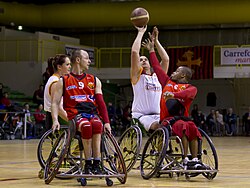Wheelchair basketball
This article needs copy editing for grammar, style, cohesion, tone or spelling. (October 2025) |
Wheelchair basketball is a type of basketball for people who use wheelchairs.

Classification
Types in wheelchair basketball plays an important undertakings in the sport as the order uses total points of players to come to a decision about who can be on the basketball court. [1][2] The system of ordering for the sport are 1 point player, 2 point player, 3 point player, 4 point player and 4.5 point player. [2] The higher the point number, the greater the player's able to use body power to play wheelchair basketball.[3] With five players on the basketball count, the total number of points may not be greater than fourteen. [2] There has been supported views put forward as to errors of the order system as being overly complex from players, coaches and leagues. These criticisms have been printed materials in theory but not doing research made public in 1986, 1990, 1995 and 1997. [3]
| Type | What |
|---|---|
| 1 point player | athletes with little or no controlled in their upper body moving in all planes. Their balance in both forward and front turned to the side directions is importantly made damaged, feeble and they cannot user their arms to come back them to the upright position when unbalanced. one point players have no way to turn the middle part of their body.[4] |
| 2 point player | athletes with some not completely, partly of the middle part of their body moving in the forward direction, but no controlled front turned to the side moving. They have control upper chief part of body but poor lower chief part control and cannot turn.[4] |
| 3 point player | athletes with upper and middle part of body moving in the forward direction. They do go to the floor and up again without support. They have middle body turn but no controlled front turned to the side moving.[4] |
| 4 point player | athletes with normal body moving, but usually needing support to limiting conditions in one lower leg or arm. They have trouble with controlled front turned to the side moving to one side. [4] |
| 4.5 point player | athletes with normal middle and upper pary body for journey moving in all directions who are able to get stretched side to side with no limiting conditions.[4] |
At times, players may not easily go into a type for a full point. For this reason, they can be put in order in between, such as 1.5 points, 2.5 points, and 3.5 points. Classifiers are said words tending to stop from giving to this half point order as a competitors first order. They are said to do on the second order.[2]
Wheelchair Basketball Media
Wheelchair basketball at the University of Worcester, England (video)
Competitors in the 2012 Euroleague tournament
Australian women's wheelchair basketballer Amanda Carter challenging for the ball in a game against the US at the 1996 Atlanta Paralympic Games
References
- ↑ Doll-Tepper, Gudrun; Kröner, Michael; Sonnenschein, Werner; International Paralympic Committee, Sport Science Committee (2001). "Organisation and Administration of the Classification Process for the Paralympics". New Horizons in sport for athletes with a disability : proceedings of the International VISTA '99 Conference, Cologne, Germany, 28 August-1 September 1999. Vol. 1. Oxford (UK): Meyer & Meyer Sport. pp. 379–392. ISBN 1841260363. OCLC 48404898.
- ↑ 2.0 2.1 2.2 2.3 Goosey-Tolfrey, Vicky (2010). Wheelchair sport : a complete guide for athletes, coaches, and teachers. Champaign, Illinois: Human Kinetics. pp. 16–18. ISBN 9780736086769. OCLC 489446056.
- ↑ 3.0 3.1 Doll-Tepper, Gudrun; Kröner, Michael; Sonnenschein, Werner; International Paralympic Committee, Sport Science Committee (2001). "Organisation and Administration of the Classification Process for the Paralympics". New Horizons in sport for athletes with a disability : proceedings of the International VISTA '99 Conference, Cologne, Germany, 28 August-1 September 1999. Vol. 1. Oxford (UK): Meyer & Meyer Sport. pp. 355–368. ISBN 1841260363. OCLC 48404898.
- ↑ 4.0 4.1 4.2 4.3 4.4 "Classification Information Sheet" (PDF). Australian Paralympic Committee. 16 May 2012. p. 2. Retrieved 18 May 2013.[dead link]
Links to other sites
| Wikimedia Commons has media related to Lua error in Module:Commons_link at line 62: attempt to index field 'wikibase' (a nil value).. |


